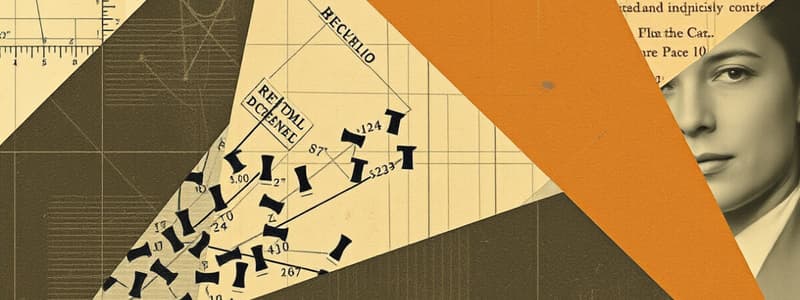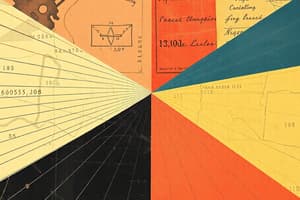Podcast
Questions and Answers
Which of the following best describes a ray?
Which of the following best describes a ray?
- A figure formed by two rays that share a common endpoint.
- A straight path that has two endpoints.
- A portion of a line that starts at a point and extends infinitely in one direction. (correct)
- A flat surface that extends infinitely in all directions.
What is the relationship between parallel lines cut by a transversal?
What is the relationship between parallel lines cut by a transversal?
- Alternate interior angles are congruent. (correct)
- Corresponding angles are always supplementary.
- Consecutive interior angles are always equal.
- All angles formed are acute angles.
When constructing perpendicular lines, what characteristic must they meet?
When constructing perpendicular lines, what characteristic must they meet?
- They must intersect at an angle of 90 degrees. (correct)
- They must lie on the same plane.
- They must intersect at an angle of 45 degrees.
- They should not intersect at any angle.
Which of the following correctly defines a plane?
Which of the following correctly defines a plane?
If two parallel lines are cut by a transversal, what can be concluded about the same-side interior angles?
If two parallel lines are cut by a transversal, what can be concluded about the same-side interior angles?
Flashcards are hidden until you start studying
Study Notes
Geometric Concepts and Relationships
- Points, Lines, Rays, and Line Segments: Understand and illustrate basic geometric figures by using models; a point represents a location, a line extends infinitely in both directions, a ray has one endpoint and extends indefinitely in one direction, and a line segment has two endpoints.
- Angles and Planes: Describe angles as the intersection of two rays with a common endpoint (vertex), while a plane is a flat surface that extends infinitely in two dimensions.
Line Construction
- Perpendicular Lines: Construct lines that intersect at a right angle (90 degrees), indicating a specific geometric relationship between the two lines.
- Parallel Lines: Create lines that run alongside each other and never intersect, maintaining equal distance apart.
Angle Relationships with Transversals
- Transversal Lines: Identify a transversal as a line that crosses at least two other lines; crucial for understanding angles formed by parallel lines.
- Angle Relationships: Recognize relationships such as corresponding angles, alternate interior angles, and same-side interior angles that arise when a transversal intersects parallel lines.
Angle Measurement and Calculation
- Angle Pairs Involving Transversals: Calculate angle measures for pairs of angles formed by intersecting lines; this includes supplementing and complementing relationships depending on the lines' orientations.
- Application of Angles: Apply knowledge to solve problems involving angle pairs, with focus on pairs formed from parallel and perpendicular lines as well as those through transversals.
Studying That Suits You
Use AI to generate personalized quizzes and flashcards to suit your learning preferences.




